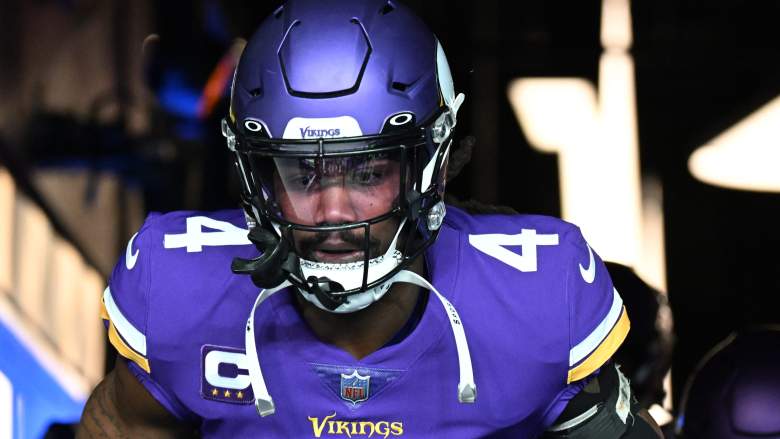
Getty Dalvin Cook of the Minnesota Vikings.
Saquon Barkley and Dalvin Cook are the leading indicators that a brave new world has dawned in the NFL.
For years, the league has all but taken out billboards on major highways and full-page ads announcing that the days of running backs mattering are over.
Yet, that hasn’t exactly proven accurate by how teams have conducted business over the past half-decade.
Since the 2018 NFL draft, when Barkley was chosen No. 2 overall by the New York Giants, there have been nine running backs chosen in the first round. That includes the Atlanta Falcons taking Texas standout Bijan Robinson at No. 8 overall and the Detroit Lions taking Alabama speedster Jahmyr Gibbs at No. 12, this year, before flipping veteran D’Andre Swift to the Philadelphia Eagles in a trade later in the draft.
In an analytics-driven NFL, where running-backs-by-committee have become the norm, it isn’t that running backs don’t matter, it is that the league has decided it is cheaper with far more upside to prioritize youth at the position. Especially given the structure of the rookie wage scale that pays a maximum of $1.57 million from the second round of the draft onward.
“I think it’s just really hard to commit heavy, long-term dollars to that position,” an NFC personnel executive told Heavy.
Never might this new reality be more evident than Cook’s plight.
Dalvin Cook Could Have ‘Some Trouble’ Getting Big Offer
Just last season, Cook rushed for 1,173 yards with 8 touchdowns, while catching 39 passes for 295 yards and 2 touchdowns, while rattling off 30 explosive runs of 10 yards or more and forcing 51 missed tackles. At age 27.
Cook was released on June 9, after the Minnesota Vikings tried and failed to find a trade partner. It will be Alexander Mattison headlining the Vikings’ backfield, set to count $4.6 million against the cap this season, $5.8 million cheaper than Cook would have been.
“I think Cook will have some trouble getting a big commitment,” the executive said.
Gone, it seems, are the days of a bell cow back being the norm for NFL offenses. Back in 2005, there were 10 running backs who logged more than 300 carries, with Clinton Portis, Tiki Barber, Edgerrin James and Shaun Alexander all toting the rock at least 350 times. By comparison, only three running backs had more than 300 rushing attempts last season, with Derrick Henry carding a league-high 349.
Barkley has gone so far as to suggest he would consider holding out the entire season, frustrated by front office leaks and how the New York Giants have handled his contract talks after using the franchise tag on him back in March.
“Me getting tagged, was I upset about it? Nobody wants to get tagged,” Barkley told reporters at his annual youth football camp. “To sit here and say I was frustrated, I was mad, I was upset, what really got me upset was the stories that got leaked out and how misleading they were and how untruthful they were.”
In 2022, finally fully healthy from a torn ACL suffered Week 2 of the 2020 campaign, Barkley rushed for a career-high 1,312 yards with 10 touchdowns.
Whether Barkley’s situation with the Giants will get resolved remains to be seen. So, too, it sounds whether he will step foot onto an NFL field this season under the franchise tag.
“There’s no doubt this league is moving away from big second contracts for the top running backs,” a current NFL agent told Heavy. “If I were advising Saquon, I would do a three-year deal worth $30 million fully guaranteed, if we could get it. That would be three years of the current going rate for a franchise running back.”
There is certainly inherent risk of running backs’ production dipping as their careers progress, and added injury risk from the accumulation of all those touches. But, in an era where carries are largely split between committees, the top players at the position have not seen their compensation rise nearly to the level of other premium positions.
NFL Running Back Expenditure Nearing Kickers
Across the league, the average cap spending at the running back position is just $11 million, while wide receivers check in at $28.4 million on average and tight ends at $11.9 million.
How out of hand has the devaluation of running backs become? The average expenditure at the kicker position is $6.4 million against the cap, and five teams across the league spend $7.1 million or less at the running back position.
Something has to give. It’s either time for NFL teams to reevaluate and recognize the value the premier playmakers at the running back position offer, or else players to drastically change the way they structure their contracts to ensure the most possible guaranteed money upfront.
“It’s all about respect,” Barkley told reporters. “That’s really what it is.”